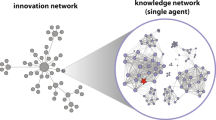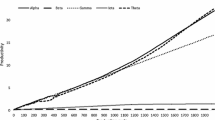Abstract
We apply an agent-based simulation approach to explore how and why typical network characteristics affect overall knowledge diffusion properties. To accomplish this task, we employ an agent-based simulation approach (ABM) which is based on a “barter trade” knowledge diffusion process. Our findings indicate that the overall degree distribution significantly affects a network’s knowledge diffusion performance. Nodes with a below-average number of links prove to be one of the bottlenecks for an efficient transmission of knowledge throughout the analysed networks. This indicates that diffusion-inhibiting overall network structures are the result of the myopic linking strategies of the actors at the micro level. Finally, we implement policy experiments in our simulation environment in order to analyse consequences of selected policy interventions. This complements previous research knowledge on diffusion processes in innovation networks.










Similar content being viewed by others
Notes
Notably, in the model absorptive capacities are similar for all firms and exogeneously given. Hence, they can be considered as an industry level parameter rather than an agent-level parameter. An alternative approach has been conseptualized and applied by Savin and Egbetokun (2016).
The exact rewiring procedure works as follows: The starting point is a ring lattice with n nodes and k links. In a second step, each link is then rewired randomly with the probability p. By altering the parameter p between \(p=0\) and \(p=1\), i.e. the network can be transformed from regularity to disorder.
In this paper we analyse diffusion processes in existing networks. In the case of the EV algorithm we assume that the linking process is repeated 100 times. To create comparable networks with a pre-defined number of links we further assume that links are deleted after 2 time steps of the rewiring process.
See also Fig. 2: The point in time the knowledge stock in the network has reached its steady state \(\bar{v}^{*}\) is \(t{^{*}=61}\) for Watts–Strogatz networks, \(t{^{*}=55}\) for Erdös–Rényi networks, \(t{^{*}=45}\) for Barabási–Albert networks and \(t{^{*}=32}\) for networks created with the Evolutionary network algorithm.
To determine why a node stops trading we define a variable for each node which contains the information on whether its unsuccessful trades failed because the respective node had insufficient knowledge or whether its trading partner actually had insufficient knowledge. The colour marking indicates the average results over a simulation run of 100 time steps.
In the policy intervention, we define ‘stars’ as those 10 % of all nodes that have the highest degree centrality, whereas ‘small’ is defined as those 10 % of the distribution that have the lowest degree centrality. ‘Medium’ agents are those 80 % of the distribution that are neither ‘stars’ nor ’small’. To measure the performance of the policy interventions we measure the steady-state knowledge stock \(\bar{v}\) for every policy after 100 simulation steps and over 500 simulation runs.
References
Ahuja G (2000) Collaboration networks, structural hole, and innovation: a longitudinal study. Admin Sci Q 45(3):425–455
Baum JA, Calabrese T, Silverman BS (2000) Don’t go it alone: alliance network composition and startup’s performance in Canadian biotechnology. Strateg Manag J 21(3):267–294
Barabási AL, Albert R (1999) Emergence of scaling in random networks. Science 286(5439):509–512
Bollobás B, Riordan O, Spencer J, Tusnády G (2001) The degree sequence of a scale-free random graph process. Random Struct Algorithms 18(3):279–290
Borgatti SP, Everett MG (1999) Models of core/periphery structures. Soc Netw 21(4):375–395
Burt R (1992) Structural holes: the social structure of competition. Harvard, Cambridge
Cattani G, Ferriani S (2008) A core/periphery perspective on individual creative performance: social networks and cinematic achievements in the hollywood film industry. Organ Sci 19(6):824–844
Coleman JS (1988) Social capital in the creation of human capital. Am J Sociol 94:S95–S120
Cowan R, Jonard N (2007) Structural holes, innovation and the distribution of ideas. J Econ Interact Coord 2(2):93–110
Cowan R, Jonard N (2004) Network structure and the diffusion of knowledge. J Econ Dyn Control 28(8):1557–1575
Erdös P, Rényi A (1959) On random graphs. Publ Math Debr 6:290–297
Erdös P, Rényi A (1960) On the evolution of random graphs. Publ Math Inst Hung Acad Sci 5:17–61
Fleming L, King C, Juda AI (2007) Small worlds and regional innovation. Organ Sci 18(6):938–954
Grant RM, Baden-Fuller C (2004) A knowledge accessing theory of strategic alliances. J Manag Stud 41(1):61–84
Gilsing V, Nooteboom B, Vanhaverbeke W, Duysters G, van den Oord A (2008) Network embeddedness and the exploration of novel technologies: technological distance, betweenness centrality and density. Res Policy 37(10):1717–1731
Hanusch H, Pyka A (2007) Principles of neo-Schumpeterian economics. Camb J Econ 31(2):275–289
Hanson JR, Krackhardt D (1993) Informal networks: the company behind the chart. Harv Bus Rev 71(4):104–111
Herstad SJ, Sandven T, Solberg E (2013) Location, education and enterprise growth. Appl Econ Lett 20(10):1019–1022
Kim H, Park Y (2009) Structural effects of R&D collaboration network on knowledge diffusion performance. Expert Syst Appl 36(5):8986–8992
Kudic M, Ehrenfeld W, Pusch T (2015) On the trail of core-periphery patterns in innovation networks—measurement and new empirical findings from the German laser industry. Ann Reg Sci 55(1):187–220
Levén P, Holmstroem J, Mathiassen L (2014) Managing research and innovation networks: evidence from a government sponsored cross-industry program. Res Policy 43(1):156–168
Lin M, Li N (2010) Scale-free network provides an optimal pattern for knowledge transfer. Phys A: Stat Mech Appl 389(3):473–480
Malerba F (1992) Learning by firms and incremental technical change. Econ J 102(413):845–859
Malerba F (2007) Innovation and the dynamics and evolution of industries: progress and challenges. Int J Ind Organ 25(4):675–699
Morone P, Taylor R (2010) Knowledge diffusion and innovation: modelling complex entrepreneurial behaviours. Edward Elgar Publishing, Cheltenham
Morone A, Morone P, Taylor R (2007) A laboratory experiment of knowledge diffusion dynamics. In: Canter U, Malerba F (eds) Innovation, industrial dynamics and structural transformation. Springer, Heidelberg, pp 283–302
Morone P, Taylor R (2004) Knowledge diffusion dynamics and network properties of face-to-face interactions. J Evol Econ 14(3):327–351
Mueller M, Buchmann T, Kudic M (2014) Micro strategies and macro patterns in the evolution of innovation networks-an agent-based simulation approach in simulating knowledge dynamics. In: Gilbert N, Ahrweiler P, Pyka A (eds) Innovation networks. Springer, Heidelberg, pp 73–95
Nelson RR, Winter SG (1982) Belknap Press of Harvard University Press
OECD (1996) The knowledge-based economy. General distribution OCDE/GD 96(102)
Podolny JM (2001) Networks as the pipes and prisms of the market. Am J Sociol 7(1):33–60
Powell WW, Koput KW, Smith-Doerr L (1996) Interorganizational collaboration and the locus of innovation: networks of learning in biotechnology. Admin Sci Q 41(1):116–145
Powell WW, White DR, Koput KW, Owen-Smith J (2005) Network dynamics and field evolution: the growth of interorganizational collaboration in the life sciences. Am J Sociol 110(4):1132–1205
Powell WW, Grodal S (2005) Networks of innovators. In: Fagerberg J, Mowery DC, Nelson RR (eds) The Oxford handbook of innovation. Oxford University Press, Oxford, New York, pp 56–85
Pyka A (1997) Informal networking. Technovation 17(4):207–220
Savin I, Egbetokun A (2016) Emergence of innovation networks from R&D cooperation with endogenous absorptive capacity. J Econ Dyn Control 64:82–103
Schilling MA, Phelps CC (2007) Interfirm collaboration networks: the impact of large-scale network structure on firm innovation. Manag Sci 53(7):1113–1126
Stuart TE (2000) Interorganizational alliances and the performance of firms: a study of growth and innovational rates in a high-technology industry. Strateg Manag J 21(8):791–811
Uzzi B, Amaral LA, Reed-Tsochas F (2007) Small-world networks and management science research: a review. Eur Manag Rev 4(2):77–91
Watts DJ, Strogatz SH (1998) Collective dynamics of ‘small-world’ networks. Nature 393:440–442
Acknowledgments
We gratefully acknowledge the financial support from the Dieter Schwarz Stiftung. In addition, we would like to thank Andreas Pyka, Robin Cowan, three anonymous reviewers, the participants of the EMAEE Conference, 1–3 June 2015, Maastricht, the Netherlands and the participants of the 1st EAEPE RA[X] Workshop, 2–3 November 2015, Essen, Germany for their helpful comments and suggestions. Needless to say, we are solely responsible for any remaining errors and omissions.
Author information
Authors and Affiliations
Corresponding author
Rights and permissions
About this article
Cite this article
Mueller, M., Bogner, K., Buchmann, T. et al. The effect of structural disparities on knowledge diffusion in networks: an agent-based simulation model. J Econ Interact Coord 12, 613–634 (2017). https://doi.org/10.1007/s11403-016-0178-8
Received:
Accepted:
Published:
Issue Date:
DOI: https://doi.org/10.1007/s11403-016-0178-8




